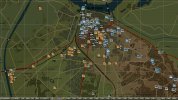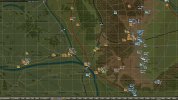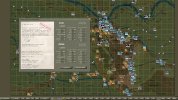The Arko of the I. SS Pz. Korps after the war claimed in a study, that radio controlled fire concentrations that he had ordered were executed 12-15 minutes after ordering the target by 40-50 batteries (150-200 gun tubes, or the equivalent of ~15 artillery battalions), which represents a corps's worth of artillery, including some batteries of neighbouring corps that were still in range of the ordered target.
Source is MS B-832."
The entire discussion was very interesting, as like one of the posters commented, it's very hard to find information on WWII German Artillery procedures, and response times, written in English.
I just stumbled over these interesting posts from Daz.
The fire concentration he described involved the equivalent of 5 full strength artillery regiments, which the player may actually have at his disposal in one or another big scenario, so such fire concentration wouldn't be a gamey strat.
Dave correctly rated the German artillery as operating "under command", but this could very well involve the support of arty units in neighboring sectors. Let me quote from the article recommended by Dave, where "under command" is described :
"The British Army did not recognise the principle of Unity of Command in the way that other armies did, instead they subscribed to Unity of Effort, a more flexible concept. The consequence of these simple arrangements was highly flexible mobile firepower that could be provided where and when it was needed.
'Under Command' meant that control was centralised under the commander, while 'In Support' meant decentralisation. ........[...] Typically a regiment 'under command' of a division would be 'in support' to a particular brigade, but this did not prevent it firing in support of formations to its flanks."
The Germans held back artillery units as Army assets (just like some AT units, in order to be able to create Schwerpunkt defenses to prevent armored enemy breakthroughs), especially on the EF, which were either assigned to particular sectors, ordered as "add-ons" to create/support Schwerpunkt bombardments or held back as Army (the typical reserve level) or Corps (rare, I think) reserve, respectively/exclusively ordered/to be assigned by the Army commander. While the Russians put entire artillery divisions and even Corps into the Stavka Reserve eventually, which the Stavka (Reserve of the Supreme High Command) could then assign to support a "Front" or individual Armies, for instance, the Germans did not believe in the creation of arty divisions, they just created 2 experimental arty divisions which were then rarely employed en bloc, so the common bodies (additionally) assigned to the different sectors (or particular Corps/divisions) used to be artillery regiments or one or more of its Abteilungen (Bns).
The article then continues to detail the more flexible British approach:
"Corps became the primary level of artillery control for counter-battery action (as it was in WW1) and in the final year of the war for major offensive fireplans. Control was usually centralised for defensive and major attack operations and decentralised for an advance. However it was rare for command to be decentralised below divisional level and decentralisation mostly applied to the army artillery being assigned to corps or division level."
As I understand it, the British approach usually still involved the rather centralized approach "under command" when on the defensive AND during major attack operations (mostly even below div. level) and the rather decentralized "in support" approach during advances - where the latter approach was mostly applied when Army artillery assets were assigned to subordinated echelons (Corps or Div).
The detailed sub-page "command & control" stresses that "the normal centralizing HQ was division for divisional artillery and
corps for artillery with
counter-battery tasks", but the article section also notes that the Field Service Regulations stressed that
"command of any body of artillery should be centralized under the highest commander who can exercise effective control". The regulations also stated that a formation commander should not have to deal with more than one artillery commander, according to the article.
This enabled the British artillery branch to get to a somewhat higher level of flexibility, as - when effective control couldn't be achieved - "then some or all units may be placed under command of a forward brigade or even regiments or batteries under command of forward units."
As I see it, technically - and in the main - vital parts of the British approach were still within the "under command" scope, though, as decentralization of command below divisional level rarely occured and as decentralization of command was rather reserved for artillery above the divisional level and for advances (for the longest time, at least).


